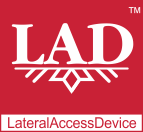
LateralAccessDevice
takes you back to before the Internet
How It Works | Download LAD | Support | LAD Security | Features & Uses | Resources | Members | User Guide
About LADLateralAccessDevice (LAD) is a commercial-grade downloadable appliance that turns a computer chassis into a high-performance, multi-purpose Internet / network management tool that combines a SIP server and VoIP PBX, routing and switching, multi-dimensional firewalling, network monitoring, access control, packet capture, DNS, NAT and a host of other applications into one easy to use, integrated, high-security package. Incorporating LateralFirewall and LateralDNS technologies, LAD is a superior tool for routing, managing, monitoring, securing and controlling your network, whether at home, in the office or anywhere else. Now supporting Wi-Fi 2.4Ghz and Wi-Fi 6E for both 5G and 6G wireless networking. How It WorksLAD is self-contained software/firmware that you install and run on your own x86 computer (x86 refers to a specific architecture of computer -- in the past it was also referred to as IBM-compatible or as having Intel or AMD CPUs inside). As far as hardware goes, you will need at least the following:
While many desktop computers would likely be compatible, if it only has one Ethernet port you will need to get a network interface card with two or more Ethernet ports for pass-through and routing functionality (see hardware recommendations). You can also get new mini-computers with multiple Ethernet ports already built in that would be suitable, if the specifications meet or exceed the minimums above. As far as the USB stick goes, the smaller (capacity-wise), the better. While any size USB stick will work, the larger its capacity, the longer it takes to prepare, so a smaller one is just more convenient. Once you have your computer lined up, download the LAD installation module and put it on a USB stick. This makes a bootable USB stick from which you will boot up your hardware to transform it into a fully-featured LAD appliance. Please note that this process will reinitialize and overwrite both the USB stick and the computer's hard drive, so any data on either of them will be overwritten and irretrievably lost. No separate operating system is required. LAD is a self-contained module that is its own operating system, running directly on the hardware, so no need for Windows, Linux or any other OS. A Little BackgroundLAD traces its origins back to a proprietary system designed to intercept packets at rates of millions of packets per second, process them in real time and store them in a database. This system, in turn traces its roots back to a unique real-time operating system with database that was built entirely from the ground up for speed, accuracy and security and was able to process staggering quantities of data in real time. Built on our experience in developing other IPCopper products — network appliances that would be placed at network chokepoints to intercept, process and examine network packets in real time with graphs and reports — LAD allows you to capture and examine every single packet, even the malicious ones. It also comprises the tools to address the malicious packets, as well as manage a computer network (including Wi-Fi), network users (including Wi-Fi), SIP telephony with VoIP PBX, blacklisting and DNS. The LAD platform serves to bring together all the useful tools for internet communications, including networking, telephony and more. It was built on a one-of-a-kind proprietary, data-driven operating system, designed to operate and deliver results in real time. Encryption is an integral part of this system, meaning it is really fast at processing data, encrypted or plain. The benefits of the integration of telephony, web, DNS, Wi-Fi, security and routing include the simplicity of operation it offers the user. And due to its efficiency in design, LAD is able to run on very low cost x86 hardware, while still delivering superior results. While not all hardware is supported, it is easy to obtain hardware compatible with LAD. Hardware aside, LAD is very fast and practical — faster hardware simply makes it faster yet. A Few Things to Keep in Mind
Enjoy! |